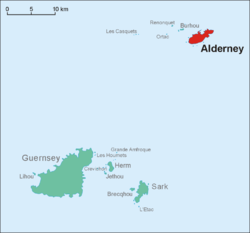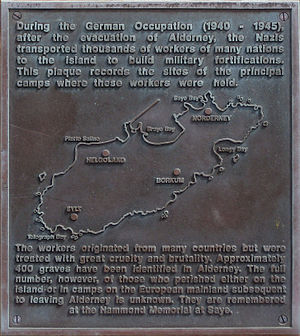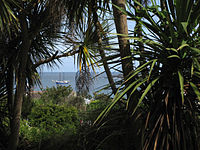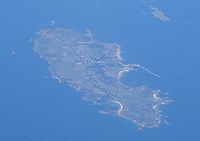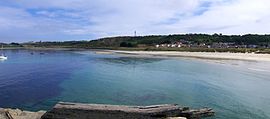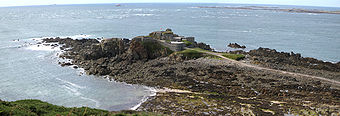- Alderney
-
Aoeur'gny
Aurigny
Alderney

Flag Coat of arms Anthem: "God Save the Queen" (official) Location of Alderney in relation to Guernsey.Capital St. Anne Official language(s) English, Legal French Recognised regional languages Auregnais Government - Head of Government Sir Norman Browse Legislature States of Alderney Part of the Bailiwick of Guernsey
(Crown dependency of the United Kingdom)- Separation from mainland Normandy
1204Population - estimate 2,400 Currency Pound sterling1 ( GBP)Time zone GMT Internet TLD .gg (Guernsey) 1 Local coinage is issued, including the pound note (see Alderney pound). Alderney (French: Aurigny; Auregnais: Aoeur'gny) is the most northerly of the Channel Islands. It is part of the Bailiwick of Guernsey, a British Crown dependency. It is 3 miles (4.8 km) long and 1.5 miles (2.4 km) wide. The area is 3 square miles (7.8 km2), making it the third-largest island of the Channel Islands, and the second largest in the Bailiwick. It is around 10 miles (16 km) to the west of La Hague on the Cotentin Peninsula, Normandy, in France, 20 miles (32 km) to the north-east of Guernsey and 60 miles (97 km) from the south coast of England. It is the closest of the Channel Islands to both France and England. It is separated from Cap de la Hague by the dangerous Race of Alderney (Le Raz Blanchard).
The island has a population of only 2,400 people and they are traditionally nicknamed vaques[1] after the cows, or else lapins[2] after the many rabbits seen in the island. Formally, they are known as Ridunians, from the Latin Riduna.
The only parish of Alderney is the parish of St Anne, which covers the whole island.
The main town, St Anne, ('La Ville', or 'Town' in English) is referred to as 'St Anne's'. It features an imposing church and an unevenly cobbled high street. There are a primary school, a secondary school and a post office, and hotels, restaurants, banks and shops. Other settlements include Braye, Newtown, Longis, Crabby and Mannez.
Contents
History
Alderney shares a history with the other Channel Islands, becoming an island in the Neolithic period as the waters of the Channel rose. Formerly rich in dolmens, like the other Channel Islands, Alderney with its heritage of megaliths has suffered through the large-scale military constructions of the 19th century and also by the Germans during the WWII occupation, who left the remains at Les Pourciaux unrecognisable as dolmens. A cist survives near Fort Tourgis, and Longis Common has remains of an Iron Age site. There are traces of Roman occupation.[3]
The etymology of the Island's name is obscure. It is known in Latin as Riduna but as with the names of all the Channel Islands in the Roman period there is a degree of confusion. Riduna may be the original name of Tatihou, while Alderney is conjectured to be identified with Sarnia. Alderney/Aurigny is variously supposed to be a Germanic or Celtic name. It may be a corruption of Adreni or Alrene, which is probably derived from an Old Norse word meaning "island near the coast". Alternatively it may derive from three Norse elements: alda (swelling wave, roller), renna (strong current, race) and oy or ey (island).
Along with the other Channel Islands, Alderney was annexed by the Duchy of Normandy in 933. In 1042 Duke William granted Alderney to the Abbey of Mont Saint Michel. In 1057 the Bishop of Coutances took control of the island.
After 1204, when mainland Normandy was incorporated into the kingdom of France, Alderney remained loyal to the English monarch in his dignity of Duke of Normandy.
Henry VIII of England undertook fortification works, but these ceased in 1554. Essex Castle perpetuates the name of the Earl of Essex, who purchased the governorship of Alderney in 1591. Prior to his execution for treason, the Earl leased the island to William Chamberlain, and Alderney remained in the hands of the Chamberlain family until 1643. From 1612, a Judge was appointed to assist the Governor's administration of Alderney, along with the Jurats. The function of the Judge was similar to that of the Bailiffs of Guernsey and Jersey, and continued until 1949.
During the Wars of the Three Kingdoms, Alderney was held by a Parliamentary garrison under Nicholas Ling, Lieutenant-Governor. Ling built Government House (now the Island Hall). The de Carterets of Jersey acquired the governorship, later passing it to Edmund Andros of Guernsey, from whom the Guernsey family of Le Mesurier inherited it, thus establishing a hereditary line of governors that lasted until 1825.
Henry Le Mesurier prospered through privateering, and moved the harbour from Longis to Braye, building a jetty there in 1736. Warehouses and dwellings were built at Braye, and the export of cattle generated wealth for the economy. The Court House was built in 1770 and a school in 1790. A Methodist chapel was constructed in 1790, following John Wesley's visit in 1787. A telegraph tower was constructed above La Foulère in 1811, enabling signals to be relayed visually to Le Mât in Sark and on to Guernsey - early warning of attack during the Napoleonic Wars was of strategic importance. With the end of those wars privateering was ended and smuggling suppressed, leading to economic difficulties.[3]
The last of the hereditary Governors, John Le Mesurier, resigned his patent to the Crown in 1825, since when authority has been exercised by the States of Alderney, as amended by the constitutional settlement of 1948.
The British government decided to undertake massive fortifications in the 19th century and to create a strategic harbour to deter attacks from France.[4] These fortifications were presciently described by William Ewart Gladstone as "a monument of human folly, useless to us ... but perhaps not absolutely useless to a possible enemy, with whom we may at some period have to deal and who may possibly be able to extract some profit in the way of shelter and accommodation from the ruins." An influx of English and Irish labourers, plus the sizeable British garrison stationed in the island, led to rapid Anglicization. The harbour was never completed - the remaining breakwater (designed by James Walker) is one of the island's landmarks, and is longer than any breakwater in the UK.
Queen Victoria and Prince Albert visited Alderney on 9 August 1854.[5] The Albert Memorial and the renaming of Rue Grosnez to Victoria Street commemorate this visit.[3]
At the same time as the breakwater was being built in the 1850s, the island was fortified by a string of 13 forts, designed to protect the harbour of refuge. The accommodation quarters of several of the forts have been converted into apartments; two are now private homes; and one, Fort Clonque, at the end of a causeway that is flooded at high tide, belongs to the Landmark Trust and can be rented for self-catering holidays. The film "Seagulls over Sorrento" was shot at Fort Clonque in 1953.
Some of the forts are now in varying stages of dereliction, the most ruined being Les Hommeaux Florains, perched on outlying rocks, its access causeway and bridge having been swept away long ago. Houmet Herbé resembles a Crusader castle with its squat round towers. Like many of the forts it included such apparently anachronistic features as a drawbridge and machicolation, which were still common in military architecture of the period.
World War II
During the Second World War, the Channel Islands were the only part of the British Commonwealth occupied by Germany. The occupation 1940–45 was harsh, with some island residents being taken for slave labour on the continent; Jews sent to concentration camps; partisan resistance and retribution; accusations of collaboration;[citation needed] and slave labour (primarily Russians and eastern Europeans) being brought to the islands to build fortifications. In Alderney, before German troops landed in June 1940, the entire population, save for six persons, left.
The Germans built four concentration camps in Alderney, subcamps of the Neuengamme concentration camp. Lager Helgoland and Lager Borkum were used by the Nazi Organisation Todt and used forced labour to build bunkers, gun emplacements, air-raid shelters and concrete fortifications. In 1942, the Lager Norderney camp, containing Russian and Polish POWs, and the Lager Sylt camp, a concentration camp holding Jewish slave labourers, were placed under the control of the SS-Hauptsturmführer Maximilian List. Over 700 of a total inmate population of 6,000 lost their lives before the camps were closed and the remaining inmates transferred to Germany in 1944.
The Royal Navy blockaded the islands from time to time, particularly following the liberation of Normandy in 1944. Intense negotiations resulted in some Red Cross humanitarian aid, but there was considerable hunger and privation during the five years of German occupation, particularly in the final months when the population was close to starvation. The Germans surrendered Alderney on May 16, 1945, eight days after the Allies formally accepted the unconditional surrender of the armed forces of Nazi Germany and the end of Adolf Hitler's Third Reich, and seven days after the liberation of Guernsey and Jersey. 2,332 German prisoners of war were removed from Alderney on 20 May 1945, leaving 500 Germans to undertake clearing up operations under British military supervision.[6] The population of Alderney was unable to start returning until December 1945.
War crime trials
After World War II, a court-martial case was prepared against ex-SS Hauptsturmführer Max List (the former commendant of Lagers Norderney and Sylt), citing atrocities on Alderney.[7] However, he did not stand trial, and is believed to have lived near Hamburg until his death in the 1980s.[8]
Since 1945
For two years after the end of World War II, Alderney was operated as a communal farm. Craftsmen were paid by their employers, whilst others were paid by the local government out of the profit from the sales of farm produce. Remaining profits were put aside to repay the British Government for repairing and rebuilding the island. Resentment from the local population towards being unable to control their own land acted as a catalyst for the United Kingdom Home Office to set up an enquiry that led to the "Government of Alderney Law 1948", which came into force on 1 January 1949. The law organised the construction and election of the States of Alderney, the justice system and, for the first time in Alderney, the imposition of taxes. The legislature and judiciary were separated: the position of Judge, which had headed the island's government since the resignation of the last Governor in 1825, was abolished, and the Jurats were removed from their legislative function.[3] As a result of the small population of Alderney, it was believed that the island could not be self-sufficient in running the airport and the harbour, or providing services that would match those of the United Kingdom. Taxes were therefore collected into the general Bailiwick of Guernsey revenue funds at the same rate as in Guernsey, and administered by the States of Guernsey. Guernsey became responsible for providing many governmental functions and services.
The 20th century saw a lot of change in Alderney, from the building of the airport in the late 1930s to the death of the last speakers of the island's Auregnais language, a dialect of the Norman language. The economy has gone from depending largely on agriculture to earning money from the tourism and finance industries. E-commerce has become increasingly important, and the island hosts the domain name registry for both Bailiwicks and over a dozen gambling website operators. One of the gambling websites is Full Tilt Poker, which is currently being prosecuted by the United States and Canadian governments. Alderney has a full regulatory authority in operation.
As a result of these upheavals and of substantial immigration, the island has been more or less completely anglicised.
Politics
Main article: Politics of AlderneyThe States of Alderney is the legislature of the island; it sends two representatives to the States of Guernsey as well. The origin of the States is unknown, but it has operated from the mediaeval period.
The States of Alderney consists of the President, directly elected every four years, and ten States Members, half elected every two years for a four-year mandate. The President of the States of Alderney is Stuart Trought. The whole island is a single constituency.
Until the reform of 1948, the States of Alderney consisted of:
- Lieutenant-Governor of Guernsey
- the Judge (appointed by the Crown, equivalent of the Bailiff in Guernsey and Jersey)
- 6 Jurats (appointed by the Crown)
- the officers of the Court of Alderney
- 4 Douzainiers (elected annually by the ratepayers)
- a Douzainier-Delegate (appointed by the Douzaine)
- 3 People's Deputies (elected by the voters for a three-year mandate; added in 1923)
While Alderney is autonomous in many respects, a number of reserved matters remain Guernsey's responsibility. These include policing, immigration, aviation, health, education, social services, childcare and adoption. Guernsey also levies various taxes and duties on Alderney, and has the power to enact criminal legislation. In addition to the powers and reserved areas above, Guernsey may also legislate on other matters with consent from the States of Alderney.[9]
Law
The Court of Alderney exercises unlimited original jurisdiction in civil matters and limited jurisdiction in criminal matters. The Court sits as a Chairman and at least three of the six Jurats. Appeals are made to the Royal Court of Guernsey, which also exercises some original jurisdiction in criminal matters in Alderney, and thence to the Judicial Committee of the Privy Council.[10]
Geography
Alderney is similar to the other Channel Islands in having sheer cliffs broken by stretches of sandy beach and dunes. The highest point is on the central plateau of the island at 296 ft.[5]
Its climate is temperate, moderated by the sea, and summers are usually warmer than elsewhere in the British Isles.
Alderney and its surrounding islets support a rich flora and fauna. Trees are rather scarce, as many were cut down in the 17th century to fuel the lighthouses on Alderney and the Casquets. Those trees that remain include cabbage trees, due to the mild climate - often miscalled "palms" but of the lily family), and there are some small woods dotted about the island. Puffins on Burhou and gannets on Les Étacs just off Alderney are a favourite of many visitors to the island. The Blonde hedgehog is a subspecies of the European hedgehog native to Alderney. The island had its own breed of cattle, called the Alderney. The pure breed became extinct in 1944, but hybrids remain elsewhere, though no longer on Alderney. In August 2005, the west coast of Alderney and associated islands, including Burhou and Ortac, were designated as Ramsar wetlands of international importance. The Alderney Wildlife Trust helps to manage the two nature reserves, at Longis and Vau du Saou.
The island is surrounded by rocks, which have caused hundreds of wrecks. There are treacherous tidal streams on either side of the island: the Swinge between Alderney and Burhou, just outside the harbour, and Le Raz between the island and the Normandy mainland. The Corbet Rock lies in the Swinge.
The geology of Alderney is mostly granites from the Precambrian period.
Culture
Language
Auregnais, the insular dialect of the Norman language, is no longer widely used with an estimated less than 20 fluent speakers. Generally, it has been more a spoken than a literary language and as such, only a few poems and written works can be found in it. French is no longer spoken in the island; it ceased to be an official language in 1966. French declined from neglect, especially in the education sector, but also because most of the population was evacuated in the Second World War. However, many if not most of the local place-names are in French or Auregnais. One or two words linger on in the Channel Island English, e.g. vraic (seaweed fertiliser), and the pronunciation of certain local names, e.g. Dupont as 'Dip-oh' rather than in the traditional Parisian fashion.
Sport
Golf, fishing and other water sports are popular, and there are many clubs and associations for sports and other leisure activities (List of Clubs & Associations). Alderney competes in the biannual Island Games. Every September, the Alderney Air Races attract a number of aircraft to compete in the deciding and final round for the European Air Racing champtionship, organised by the Royal Aero Club. This involves high-speed circuits round the airfield, lighthouse, Casquets and then back around.
The Alderney Community and Sports Centre is currently planned, with building costing £2.2m and starting in March 2012. This would include a swimming pool, two bowling lanes and and facilities within a sports hall for archery, indoor football, indoor tennis and also badminton.
Pubs
Due in part to the tourist industry but mainly to the Ridunians' traditional taste for the grape and grain (there is a common expression elsewhere in the Channel Islands that Alderney is composed of 'two thousand alcoholics, clinging to a rock') there are many restaurants and public houses. There is a vibrant and lively nightlife which is enjoyed by many especially in the summer, and informal dance music events often take place in abandoned bunkers ('bunker parties') and more organised events in and around Alderney Week at the Corporation Quarry ('Quarry parties').
It was one of the last places in the British Isles to introduce a smoking ban in pubs, shops, restaurants and other indoor public places (Guernsey, Jersey, the UK, and the Isle of Man all having outlawed this already). The States of Alderney passed the anti-smoking legislation with the President's casting vote on 13 January 2010; the legislation came into force at 4am on 1 June 2010.[11]
The island has an ageing population and is popular with people wanting somewhere quiet to retire. Because it is quiet and secluded, Alderney has attracted some famous residents, including authors T. H. White (The Once and Future King) and Elisabeth Beresford (The Wombles), cricket commentator John Arlott, cricketer Ian Botham, Beatles producer George Martin, actress Julie Andrews, and Olympic swimmer Duncan Goodhew.
Alderney Week
Alderney Week is celebrated from the Saturday before the first Monday of August, when a number of events take place. Each year the organisers pick a new theme, and there is a competition for a logo/mascot.
- The first Saturday begins with a parade of decorated brollies, bonnets and dogs to the Marais Square, where the firemen squirt their hoses into the air to "test" the brollies. There is a disco on the green, and a Quarry Party starting at 11 pm with a 1970s and 1980s theme. People dress in costume or just in wacky clothes.
- The Sunday is the day of a traditional street market. A mixture of traditional toffee apples and personal junk sales is laid out up and down the main street. Clothes, ice-creams, sweets and jewellery are all sold from tables in the street, and with dancing by the KFA, the Miss Holiday Princess Competition and music by the Alderney Band.
- Cavalcade Day takes place on the Monday, on which residents and organisations construct parade floats based upon a particular theme, before walking them though the high street and onto the green. Judging and prize giving takes place up there, as well as games, stalls and burger vans. The Alderney Blowers give a full concert, and there is a car and bike show.
- Tuesday events may include auditions, Shakespeare in the gardens, and the blessing of the fishing fleet.
- Wednesday often includes the daft raft race, though it changes days often to get the right tide. Participants build the wackiest crafts they can think up to sail around two buoys in three great races whilst being pelted with flour bombs, water bombs and hoses from the lifeboat. Although the races are friendly, many attempts at sabotage have been made, which range from standing in the way of launch, to drilling holes in the previous year's winners the night before. In the evening is the Extravaganza - a show of sketches and acts about Alderney, the theme, and inter-island competition.
- For many, the man-powered flight is the main focus of Thursday's events. Machines vary from the beautifully decorated to ones that might actually fly, although the furthest flying usually fly no more than a metre or two. There is a duck race (of numbered bath ducks). In the evening is the Battle Of The Bands, with both local and visiting bands taking part. It is held in the quarry, where people of all ages go to dance, cheer, and sit around the bonfire.
- Friday is given over to the sandcastle competition. The competitors are split into age groups - 0-5, 5-7, 7-10, 10-13 and Adult, and time-limits set for each group. The evening is given over to entertainment by the talented. The under-16 talent show (Alderney's Got Talent) is held early on, followed by the Alderney X-Factor at 9 pm.
- The torchlight procession, on the Saturday evening of the week, sees a parade of people walking through the town centre, carrying torches towards a large bonfire upon the green. The evening ends with a fireworks display and an open-air music event held in a disused quarry. This starts at midnight and finishes at 8:00am the next morning, although it has been known to continue on until 10 am with some nocturnal people, who use the radio for music. Other people make their way to the airport for their flight in the sleeping bags they slept in on the nearest soft floor they could find.
Regular entertainment during Alderney Week includes:
- The Alderney Blowers play every year. These are a group of musicians who fly from England every year to play throughout Alderney Week.
- The Alderney Island Band, a group of wind musicians of every age and ability, conducted by Sue Cooper.
- The KFA, Alderney's Pomerettes. The girls (and boys) start as Sunbeams aged about 4-7, and slowly work up until the Teen Team, learning dances with ribbons, balls, and pomerettes, and performing them at many events in Alderney Week
Miss Alderney
Miss Alderney is chosen in April–May each year at a public event held at the island hall by a panel of judges, but she also has a chance to win over the audience in a short speech and discussion with the host. A maid of honour is also chosen at the same time. Miss Alderney 2010 is 18-year-old Joanna Woodnutt, and her maid of honour is Hannah Osborne.
Alderney Stones
In April 2011, sculptor Andy Goldsworthy completed a project called Alderney Stones, commenced in 2008, in which 11 large dried-earth spheres were placed at different sites on the island. The intention is that each stone will gradually erode, at different speeds depending on the location, and in some cases revealing objects buried inside.[1] Goldsworthy has stated that he selected Alderney as "It seems to have a strong sense of layered past and a wide variety of locations in a small area."[2]
Transport
Alderney is served by Alderney Airport. There are several flights each day from Southampton, Jersey (via Guernsey) and Guernsey, with links to many parts of the United Kingdom and Europe. Aurigny Air Services serves the island with Britten-Norman Trislanders.
Boats sail regularly between the island and France, and to the other Channel Islands. A high-speed passenger ferry is operated in summer by the French company Manche Iles Express to Diélette in the commune of Flamanville, Manche in France, and to St Peter Port, Guernsey. Weekly freight services, also carrying passengers, are operated by Alderney Shipping to Poole and St Peter Port. A 12-passenger boat, the Lady Maris II, operates regular services to Cherbourg, Sark and St Peter Port.[12]
There are also frequent boat trips available. Mainbrayce, a chandler's, provides water-taxi services and water and fuel to visiting yacht crews. This can get quite hectic during the peak months of June, July and August as nearly 30,000 yacht crew members visit this harbour every year.
Due to the island's size, vehicular transport is often unnecessary, although taxis, cars and bicycles are used. The Alderney Railway is the only railway remaining in the Channel Islands, doing scheduled services to the lighthouse during the summer and special occasions such as Easter and Christmas. The railway brings a number of tourists to the island each year in the form of railway enthusiasts. During the summer season, there is an occasional bus service around the island.
Alderney allows people to ride motorbikes and mopeds without helmets and drive cars without seatbelts, but it is compulsory for under 18s to wear helmets. The international vehicle registration code is GBA.
Healthcare
Emergency Services can be called on 112 or 999.
The St John Alderney Ambulance Service operates the Ambulance Service on the Island, and is staffed by volunteers. Patients are transferred to the Mignot Memorial Hospital in St Anne, and any having major problems are then transferred to Guernsey by the Aurigny Air Services on a 24-hour emergency basis. In the event of bad weather preventing an air evacuation the transfer is achieved with the aid of the RNLI lifeboat service.
There is no paramedic service available on Alderney.
Numismatic history
- Banknote of Alderney
- Alderney pound and coinage
- Postal orders of Alderney
Panoramas
See also
- List of subcamps of Neuengamme concentration camp
- For further information on Nazi treatment of Jews and other people, see Holocaust
- Alderney Steam Packet Company
- The island is a key locale in the 1975 Jack Higgins novel The Eagle Has Landed
References
Inline
- ^ Dictionnaire Jersiais-Français, 1966; Customs, Ceremonies & Traditions of the Channel Islands, Lemprière, 1976, ISBN 0709158424
- ^ Dictionnaire Jersiais-Français, 1966
- ^ a b c d A Visitor's Guide to Guernsey, Alderney and Sark", Victor Coysh, 1983 ISBN 0861900847
- ^ Davenport, T.G., Partridge, C.W., "The Victorian Fortification of Alderney", Fort (Fortress Study Group), 1980, (8), pp21-47
- ^ a b Portrait of the Channel Islands, Lemprière, London 1970
- ^ The German Occupation of the Channel Islands, Charles G. Cruickshank, The Guernsey Press, (1975) ISBN 0-902550-02-0
- ^ The Jews in the Channel Islands During the German Occupation 1940-1945, by Frederick Cohen, President of the Jersey Jewish Congregation,http://www.jerseyheritagetrust.org/edu/resources/pdf/cijews.pdf
- ^ Noted in The Occupation, by Guy Walters, ISBN 0-7553-2066-2
- ^ http://www.justice.gov.uk/publications/docs/ICESCR-report-part1.pdf
- ^ Court Of Alderney
- ^ http://www.alderneyjournal.com/readnews.php?id=1145
- ^ States of Alderney Visit Alderney website
General
- The Alderney Story: 1939-1949, Michael St John Packe and Maurice Dreyfus (1966?) "The Alderney Society and Museum decided shortly after its inception in 1966 to collect all reliable reminiscences whether written or verbal lest with the passage of time they would be lost."
- Alderney Place Names, Royston Raymond, 1999 Alderney ISBN 0-9537127-0-2
- Noms de lieux de Normandie, René Lepelley, 1999 Paris ISBN 2-86253-247-9
External links
- Alderney official site
- Visitor information
- Aurigny Air Services - flights to Alderney
- Blue Islands Airline - flights to Guernsey, Jersey and Alderney
- Alderney language
- Fortress Alderney
- Alderney breakwater
- Alderney Elizabethan wreck
- Two webcams showing the reconstruction of Alderney's commercial quay
- Alderney Wildlife Trust
- Mainbrayce Water-taxi service for visiting yacht crews
- Important information when arriving by sea
- channelonline.tv (Channel Island portal)
- Wikitravel
- Alderney Stones art project
- For further information on Alderney concentration camps, see
- Christine O'Keefe, Appendix F: Concentration Camps: Endlösung – The Final Solution, http://www.tartanplace.com/tartanhistory/concentrationcamps.html, retrieved 2009-06-06
- Matisson Consultants, Aurigny ; un camp de concentration nazi sur une île anglo-normande (English: Alderney, a Nazi concentration camp on an island Anglo-Norman), http://www.matisson-consultants.com/affaire-papon/aurigny.htm, retrieved 2009-06-06 (French)</ref>
The Channel Islands Bailiwick of Guernsey Bailiwick of Jersey Categories:- Alderney
- Geography of the Channel Islands
- Parishes of the Channel Islands
Wikimedia Foundation. 2010.

